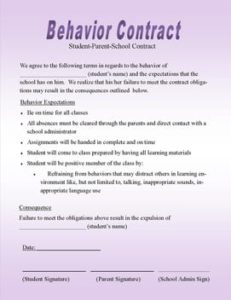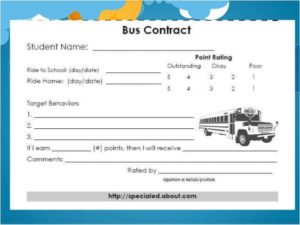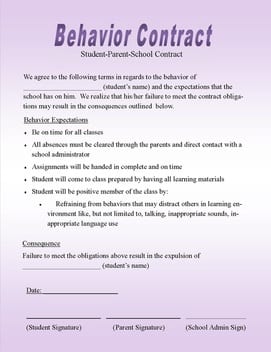Student Contributor: K. Coan
 A Verbal Plan for Improvement is as simple as a one-sentence plan that is developed by the student, stating what the student will do differently in the future. This plan is specific, realistic, brief, and stated in a positive manor. It is very important that the student state their own plan and make a commitment to following it, which can be done by writing their statement down on paper or printing it out.
A Verbal Plan for Improvement is as simple as a one-sentence plan that is developed by the student, stating what the student will do differently in the future. This plan is specific, realistic, brief, and stated in a positive manor. It is very important that the student state their own plan and make a commitment to following it, which can be done by writing their statement down on paper or printing it out.
A Verbal Plan of Improvement should be used as a form of a verbal, then written contract that the student creates and commits to. You need to keep in mind that students need to state their own plan for improvement in their own terms in order to help them become more committed to improve their behavior. Too often students are being told what to do as well as what they need to be doing differently by their teachers instead of creating their own solution to the problem/ circumstance. This plan for improvement should be used as a positive goal for students to reach and include some form of behavior that is desired rather than one that is not. A Verbal Plan for Improvement most times begins with the words “I will…” such as “I will keep my hands to myself”.
I have not had the opportunity to experience a VPI exactly, however I experienced something similar that addresses what needs to be done to make amends, rectify, or correct a wrong that was committed toward someone or something. It was formatted like a note and included a letter of things that we could do differently.
 This tool relates to the Student Directed as well as the Student Directed & Collaborative theories, as it is completely constructed by the student to help motivate them to follow through with their plan. A Verbal Plan for Improvement is based off of intrinsic motivation rather than extrinsic rewards for completing a task due to the student creating their own goal and pathway to get there for the sake of meeting their goal. I see the collaboration coming in when the teacher and their student come together and agree on the issue at hand and the teacher helps guide the student in the right direction towards his/her goal. The teacher becomes his/her support in following through with the behavior or actions that should be demonstrated in the future. This tool can also be included in the preventative phase as a students "suggestion" for a class rule/procedure. Students can begin by writing down their ideas for a classroom procedure that they find important and then state it verbally to the class when putting together a list for their own classroom procedures.
This tool relates to the Student Directed as well as the Student Directed & Collaborative theories, as it is completely constructed by the student to help motivate them to follow through with their plan. A Verbal Plan for Improvement is based off of intrinsic motivation rather than extrinsic rewards for completing a task due to the student creating their own goal and pathway to get there for the sake of meeting their goal. I see the collaboration coming in when the teacher and their student come together and agree on the issue at hand and the teacher helps guide the student in the right direction towards his/her goal. The teacher becomes his/her support in following through with the behavior or actions that should be demonstrated in the future. This tool can also be included in the preventative phase as a students "suggestion" for a class rule/procedure. Students can begin by writing down their ideas for a classroom procedure that they find important and then state it verbally to the class when putting together a list for their own classroom procedures.
More Information –
Tool Source: Vitto (2003) "Creating and Implementing Effective Consequences"



I tried this management strategy in my rural, first grade placement classroom that has 21 wonderful students in it. There are a few students who have behavioral issues that need to be addressed daily, so we discussed our options and figured we would try this one out — as it is student directed, can be used for any grade level, and is part of the corrective phase which is what we needed as these bad behaviors were already happening. Students set two goals for themselves, and it is printed on a piece of paper at the top of their desk. We noticed that the students who have these VPI’s are often excited to go over their goals at the end of the day to see if they got their “points” or if they need to work a little extra hard to get them tomorrow. I think coming up with something that doesn’t seem like a reward or a punishment within this strategy would be beneficial so students aren’t checking their behavior JUST because they know they’ll be rewarded, but because they want to. Overall, this management strategy has been working well in my placement classroom and we have planned on continuing to use it.